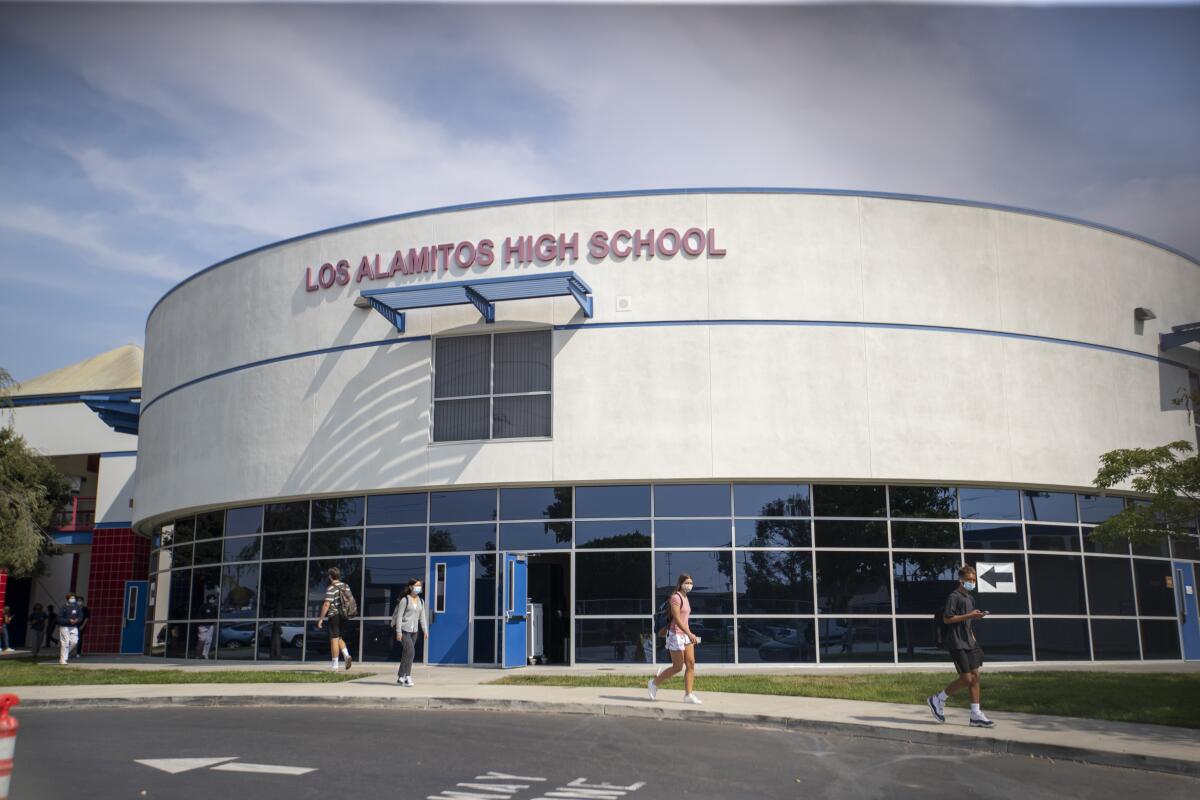Los Alamitos schools stand up to the bullies

- Share via
It’s hard to imagine people objecting to children and teenagers being taught to understand and embrace themselves and their role in society, and to do the same for others. Those are the standards for teaching social justice outlined by the Southern Poverty Law Center. Be kind to yourself and others. Be willing to find out about different people and different cultures. Learn how to approach people in respectful ways.
Yet from the objections of various factions in the Los Alamitos Unified School District, which adopted the standards this week, you would have thought that the elements called for, at a minimum, telling white kids that they are evil for being white. Maybe the opponents — at least some of whom don’t appear to be parents in the district — confused it with the first draft of a model curriculum for ethnic studies in the state. But even that curriculum, which seemed to have been drawn up to sow division, has been rewritten. And rewritten. And rewritten.
The “Teaching Tolerance” document is so benign in its calls for students to learn kindness and inclusivity, it reads almost like something out of the mid-20th century’s National Brotherhood Week. It’s worth remembering that Brotherhood Week had its origins in a period of rampant anti-Catholic and anti-Semitic sentiment, similar to the divisiveness and intolerance we are witnessing today in our nation.
In the face of the inexplicable public pushback against an attempt to build a more harmonious society, the school board stuck to its convictions. It had to do that in a remote meeting because the debate had gone beyond the usual boundaries of civil discourse, with opposing sides mustering large and angry groups of allies. Police warned the board that it was better off not holding an in-person meeting. What better evidence could there be that we need to teach a more harmonious way of living, starting in the earliest grades?
Perhaps the vehement objection has to do with the standards’ origins in the Southern Poverty Law Center, the organization behind a widely cited but overly broad and actually dangerous list of “hate groups,” many of which don’t remotely fit the definition. But its Teaching Tolerance work has been excellent, focusing on true understanding of all groups — including white people. People should look at what the standards actually say, not which organization wrote them.
“Students will express pride, confidence and healthy self-esteem without denying the value and dignity of other people,” one of the standards reads. Another goes: “Students will respectfully express curiosity about the history and lived experiences of others and will exchange ideas and beliefs in an open-minded way.”
They call for rejecting stereotypes and reducing bias, standing up for those who are bullied and not giving in to peer pressure. This is hardly radical stuff.
Or perhaps the backlash is connected to the board’s plan for an ethnic studies curriculum, which may be based on the state model but does not have to be — that’s up to the district, with the public having a chance to help hone the fine points. It’s true that the first version of the curriculum was unacceptable, but it’s been improved tremendously. If the district sticks to the positive messages of its standards, all should be well.
The Los Alamitos schools are at a juncture that might feel uncomfortable to many. It’s a relatively affluent district — 20% of its students are low-income, compared with 80% in L.A. Unified. And only in the last few years have white students gone from majority to minority. Longtime residents who have not had to contend with issues of poverty and multiculturalism are being asked to do so through these standards. It’s quite possible that they are ready and that the backlash comes from a small contingent. In any case, change is here, and it’s time to deal with it in a positive way.
We are coming up on the one-year anniversary of George Floyd’s death at the knee of a white police officer, which triggered a prolonged and painful reckoning with the country’s long history of stereotyping and mistreating Black people. In more recent months, we have witnessed outrageous violent attacks against Asian American people. Anti-Semitism has become rampant again. Our society’s prejudices are literally killing people — largely, the most marginalized among us.
A set of social justice standards for schools is not a nice idea or a bad idea. It is a necessity.
More to Read
A cure for the common opinion
Get thought-provoking perspectives with our weekly newsletter.
You may occasionally receive promotional content from the Los Angeles Times.









